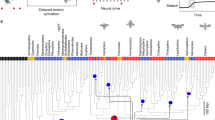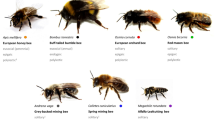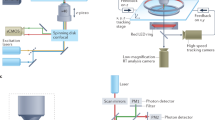Abstract
AMONG insects, an encounter with a particular stimulus1–4 or the performance of a particular activity5–7 may change the animal's later responsiveness to other stimuli or may prime the regular appearance of a stereotyped action pattern. Thus, various unrelated species display strictly predictable behavioural changes which depend not only on simultaneous events in the external environment as well as on general physiological variables, but also on well determined sensory or motor components of the subject's antecedent behaviour. The study of these changes may aid the understanding of the nature of specific internal mechanisms which are influenced by previous behavioural states and which act in turn on the animal's subsequent behaviour. This may be of special interest in the study of highly elaborate action patterns, such as the figure-of-eight dance of the honey bee. In this example, the return of the bee from a given food source to the hive is followed by a precisely defined pattern of locomotion, in which the timing and orientation of certain parameters depend on specific aspects of the insect's outgoing flight8. A series of experiments analysed the reactions of the aquatic dragonfly larva Aeschna cyanea M. after a brief presentation of an artificial prey stimulus. They revealed that the behaviour of the insect is influenced by the nature and former location of the stimulus, even after the latter has disappeared9. On the other hand, after a more extended presentation of a moving target—a stimulus which typically elicits prolonged tracking behaviour—the insect reliably carries out a strongly stereotyped pattern of locomotion, the form, control and function of which are described here.
This is a preview of subscription content, access via your institution
Access options
Subscribe to this journal
Receive 51 print issues and online access
$199.00 per year
only $3.90 per issue
Buy this article
- Purchase on SpringerLink
- Instant access to full article PDF
Prices may be subject to local taxes which are calculated during checkout
Similar content being viewed by others
References
Dethier, V. G., Science, 125, 331 (1957).
Dethier, V. G., Solomon, R. L., and Turner, L. H., J. comp. Physiol. Psychol., 60, 303 (1965).
Kennedy, J. S., J. exp. Biol., 45, 215 (1966).
Kennedy, J. S., in Experimental Analysis of Insect Behaviour, 1 (edit. by Barton Browne, L.), (Springer, Berlin-Heidelberg-New York, 1974).
Blest, D., Behaviour, 16, 188 (1960).
Graham, K., Nature, 191, 519 (1961).
Bennet, R. B., and Borden, J. H., Ann. Entom. Soc. Am., 64, 1273 (1971).
Frisch, K. von, The Dance Language and Orientation of Bees (Harvard University Press, Cambridge, Massachusetts, 1967).
Etienne, A. S., Anim. Behav., 20, 724 (1972).
Hoppenheit, M., Zool. Anz., 172, 216 (1964).
Author information
Authors and Affiliations
Rights and permissions
About this article
Cite this article
ETIENNE, A. Stereotyped pattern of locomotion controlled by duration of previous tracking by a predatory insect. Nature 260, 426–428 (1976). https://doi.org/10.1038/260426a0
Received:
Accepted:
Issue date:
DOI: https://doi.org/10.1038/260426a0
This article is cited by
-
Odonata (dragonflies and damselflies) as a bridge between ecology and evolutionary genomics
Frontiers in Zoology (2016)
-
Energy versus time dependent parameters in the determination of a behavioural sequence in theAeschna larva
Journal of Comparative Physiology ? A (1978)



